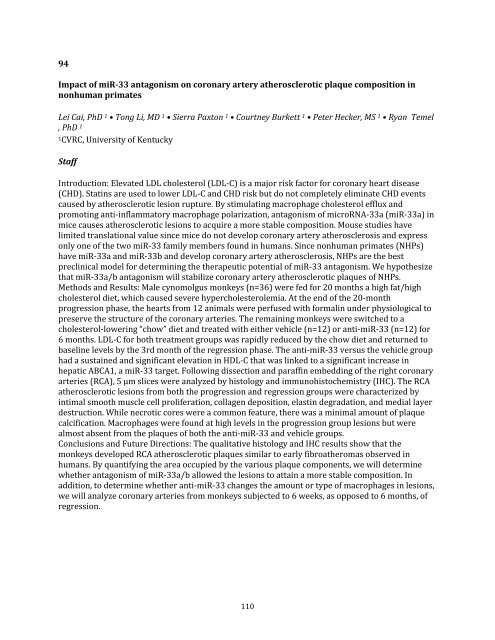2017 Cardiovascular Research Day Abstract Book
Create successful ePaper yourself
Turn your PDF publications into a flip-book with our unique Google optimized e-Paper software.
94<br />
Impact of miR-33 antagonism on coronary artery atherosclerotic plaque composition in<br />
nonhuman primates<br />
Lei Cai, PhD 1 • Tong Li, MD 1 • Sierra Paxton 1 • Courtney Burkett 1 • Peter Hecker, MS 1 • Ryan Temel<br />
, PhD 1<br />
1CVRC, University of Kentucky<br />
Staff<br />
Introduction: Elevated LDL cholesterol (LDL-C) is a major risk factor for coronary heart disease<br />
(CHD). Statins are used to lower LDL-C and CHD risk but do not completely eliminate CHD events<br />
caused by atherosclerotic lesion rupture. By stimulating macrophage cholesterol efflux and<br />
promoting anti-inflammatory macrophage polarization, antagonism of microRNA-33a (miR-33a) in<br />
mice causes atherosclerotic lesions to acquire a more stable composition. Mouse studies have<br />
limited translational value since mice do not develop coronary artery atherosclerosis and express<br />
only one of the two miR-33 family members found in humans. Since nonhuman primates (NHPs)<br />
have miR-33a and miR-33b and develop coronary artery atherosclerosis, NHPs are the best<br />
preclinical model for determining the therapeutic potential of miR-33 antagonism. We hypothesize<br />
that miR-33a/b antagonism will stabilize coronary artery atherosclerotic plaques of NHPs.<br />
Methods and Results: Male cynomolgus monkeys (n=36) were fed for 20 months a high fat/high<br />
cholesterol diet, which caused severe hypercholesterolemia. At the end of the 20-month<br />
progression phase, the hearts from 12 animals were perfused with formalin under physiological to<br />
preserve the structure of the coronary arteries. The remaining monkeys were switched to a<br />
cholesterol-lowering “chow” diet and treated with either vehicle (n=12) or anti-miR-33 (n=12) for<br />
6 months. LDL-C for both treatment groups was rapidly reduced by the chow diet and returned to<br />
baseline levels by the 3rd month of the regression phase. The anti-miR-33 versus the vehicle group<br />
had a sustained and significant elevation in HDL-C that was linked to a significant increase in<br />
hepatic ABCA1, a miR-33 target. Following dissection and paraffin embedding of the right coronary<br />
arteries (RCA), 5 µm slices were analyzed by histology and immunohistochemistry (IHC). The RCA<br />
atherosclerotic lesions from both the progression and regression groups were characterized by<br />
intimal smooth muscle cell proliferation, collagen deposition, elastin degradation, and medial layer<br />
destruction. While necrotic cores were a common feature, there was a minimal amount of plaque<br />
calcification. Macrophages were found at high levels in the progression group lesions but were<br />
almost absent from the plaques of both the anti-miR-33 and vehicle groups.<br />
Conclusions and Future Directions: The qualitative histology and IHC results show that the<br />
monkeys developed RCA atherosclerotic plaques similar to early fibroatheromas observed in<br />
humans. By quantifying the area occupied by the various plaque components, we will determine<br />
whether antagonism of miR-33a/b allowed the lesions to attain a more stable composition. In<br />
addition, to determine whether anti-miR-33 changes the amount or type of macrophages in lesions,<br />
we will analyze coronary arteries from monkeys subjected to 6 weeks, as opposed to 6 months, of<br />
regression.<br />
110


